Invest 30 seconds...
...for what may lead to a life altering association!
Help Line
- +91.8800.2828.00 (IND)
- 1030-1830 Hrs IST, Mon-Sat
- support@expertsglobal.com
...for what may lead to a life altering association!


Critical Reasoning Inference questions ask you to identify a statement that must be true based on the given information, without adding any assumptions, extrapolation, or exaggeration. This question type encourages careful reading and helps you practice drawing precise, reliable insights from what is directly stated. Consistent work with this question type is an essential part of any end-to-end GMAT preparation course. This page offers you an organized subtopic wise playlist, along with a few worked examples, for efficient preparation of this concept.
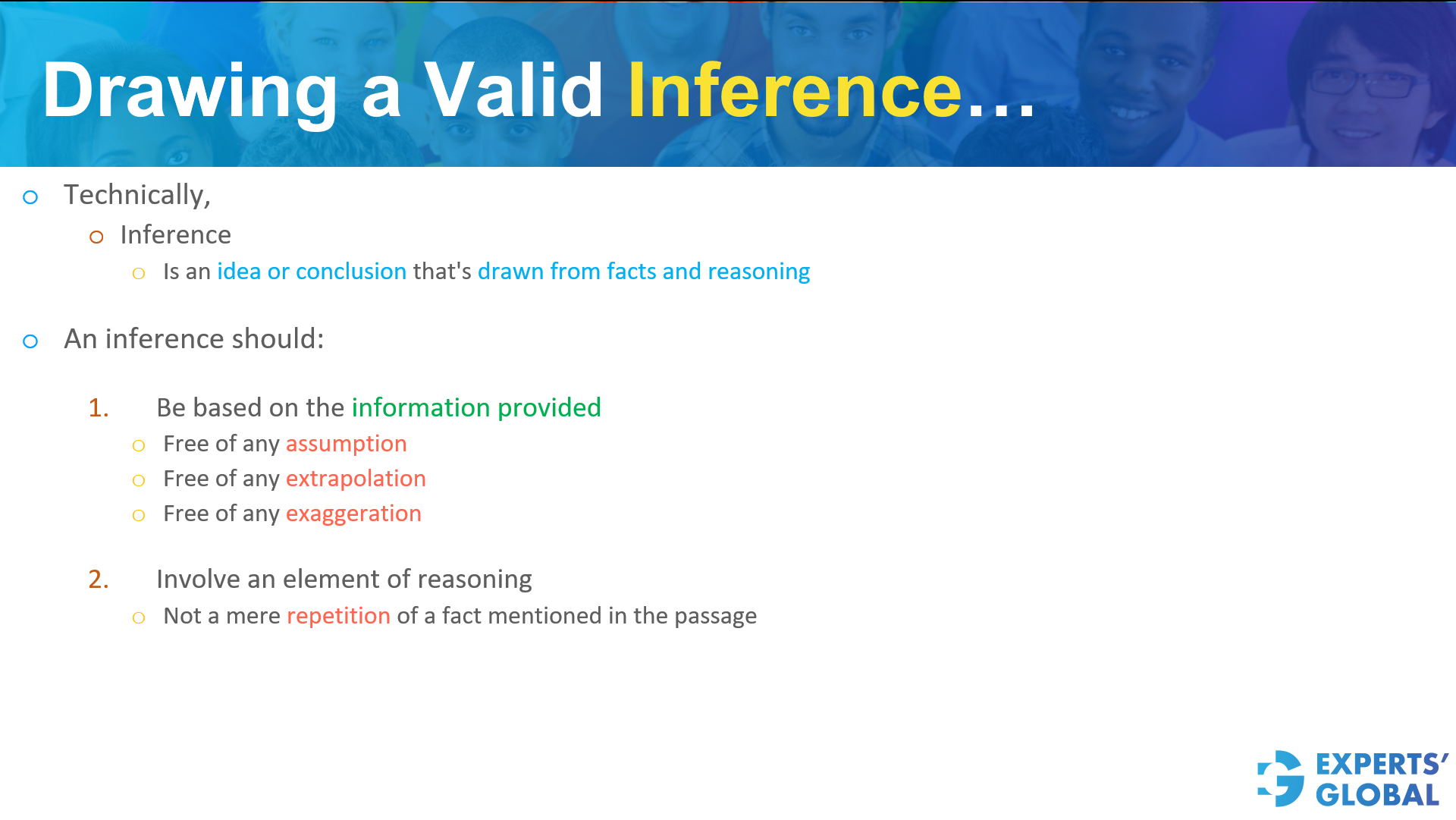
Inference questions call for careful reading and steady, disciplined reasoning. A valid inference must emerge directly from the stated facts, without extra conditions or imaginative extensions. The video and article show how to map the given information, screen out attractive but invalid choices, and remain strictly within the limits of the logic provided. In the short video that follows, this approach is clarified, illustrated, and readied for use in GMAT drills, sectional tests, and full-length GMAT practice tests.

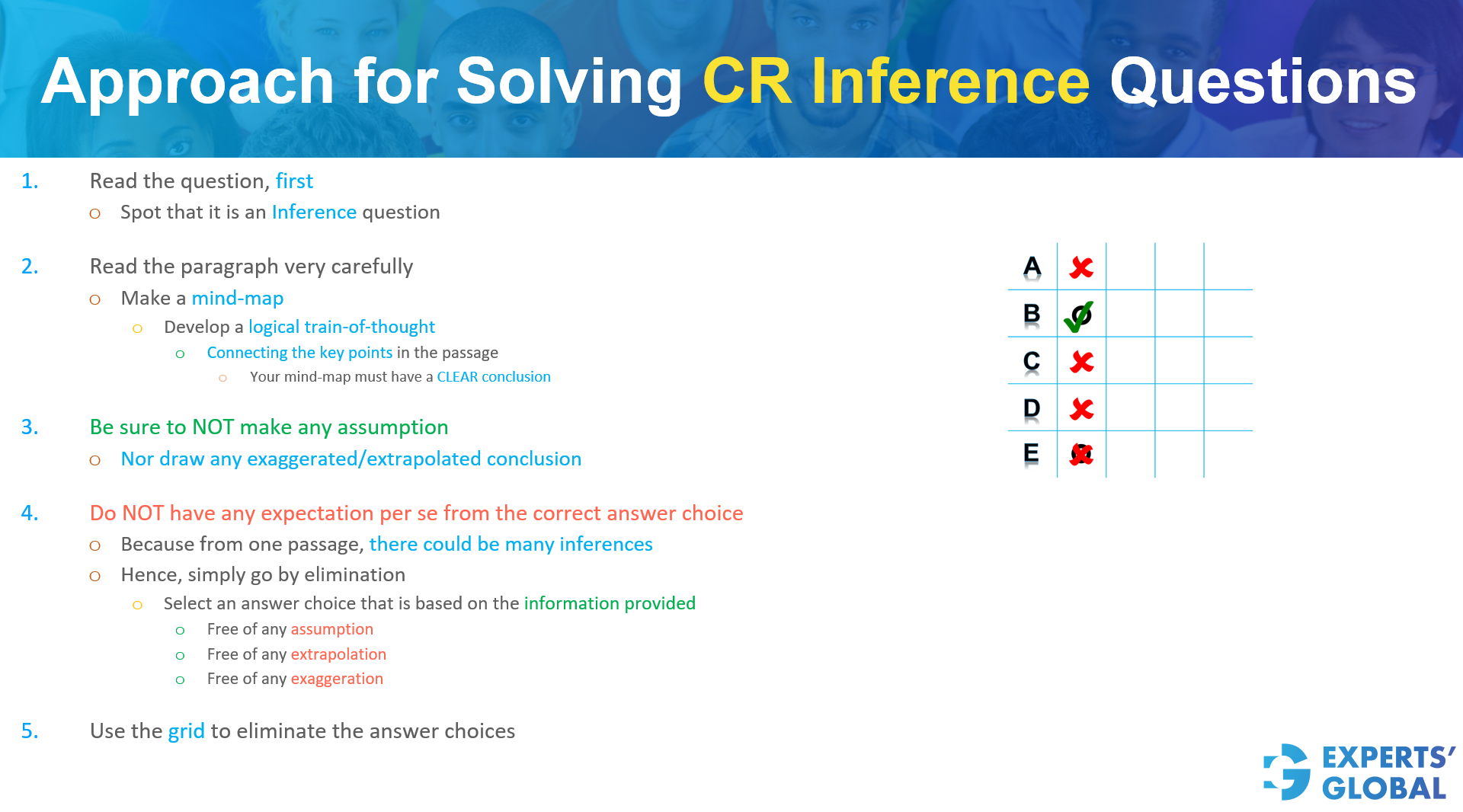
In this section, you will work through a collection of authentic GMAT-style Critical Reasoning Inference questions, each accompanied by a clear, carefully written explanation. Move through every stimulus at a measured pace and consciously apply the inference approach and ideas you have just studied on this page for such questions on the GMAT. At this stage, give greater importance to following the reasoning method accurately than to simply picking the option that seems right. After you have answered a question, use the explanation control to reveal the correct choice and review the full descriptive reasoning.
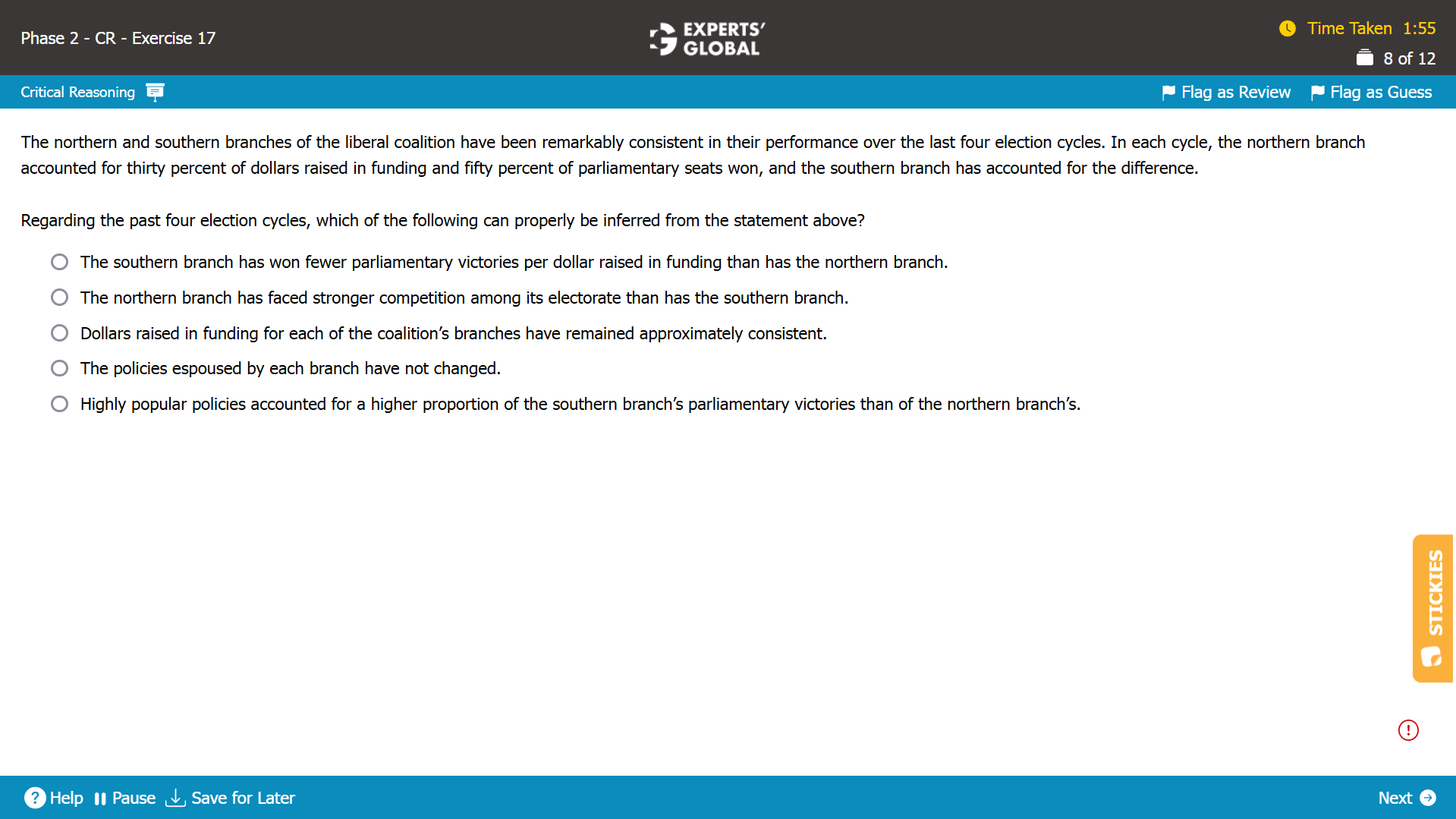
Show Explanation

Written Explanation
Mind-map: Northern and southern branches performed consistently over four election cycles → in each cycle, northern branch accounted for thirty percent funding dollars and fifty percent seats won → southern branches accounted for the rest
Missing-link: Not needed
Expectation from the correct answer choice: To be duly deducible from the information in the passage, without any assumption or extrapolation
Note: Please be extra careful when you see numbers/percentages/proportions in CR questions; often, the key lies in the numbers.
A. Correct. The passage mentions that the northern branch won fifty percent of seats for thirty percent funding dollars, whereas the southern branch won fifty percent of seats for seventy percent funding dollars; it can be inferred that, to win the same number of seats, the southern branch used more funding dollars than the northern branch did; or, in other words, the southern branch won fewer seats won per dollar raised than the northern branch did, as the answer choice mentions. Because this answer choice is deducible from the information in the passage without any assumption or extrapolation, this answer choice is correct.
B. The passage makes no mention of competition as a factor in the northern and southern branches’ performance; so, this answer choice, suggesting that the northern branch faced stronger competition, cannot be established. Because this answer choice is not deducible from the information in the passage without any assumption or extrapolation, this answer choice is incorrect.
C. Trap. This answer choice commits the classic GMAT error of confusing “percentage” with “absolute numbers”; the passage mentions “percentage” of northern and southern branches’ contribution towards funding dollars and seats won but makes no mention of any “absolute” dollar amount; so, this answer choice, making a statement about absolute dollar amounts, cannot be established. Because this answer choice is not deducible from the information in the passage without any assumption or extrapolation, this answer choice is incorrect.
D. The passage makes no mention of the change in policy as a factor in the northern and southern branches’ performance; so, this answer choice, suggesting that the policies in both the branches were unchanged, cannot be established. Because this answer choice is not deducible from the information in the passage without any assumption or extrapolation, this answer choice is incorrect.
E. Trap. The passage makes no mention of the popularity of policies as a factor in the northern and southern branches’ performance; so, this answer choice, suggesting an influence of the popularity of policies, cannot be established. Because this answer choice is not deducible from the information in the passage without any assumption or extrapolation, this answer choice is incorrect.
A is the best choice.
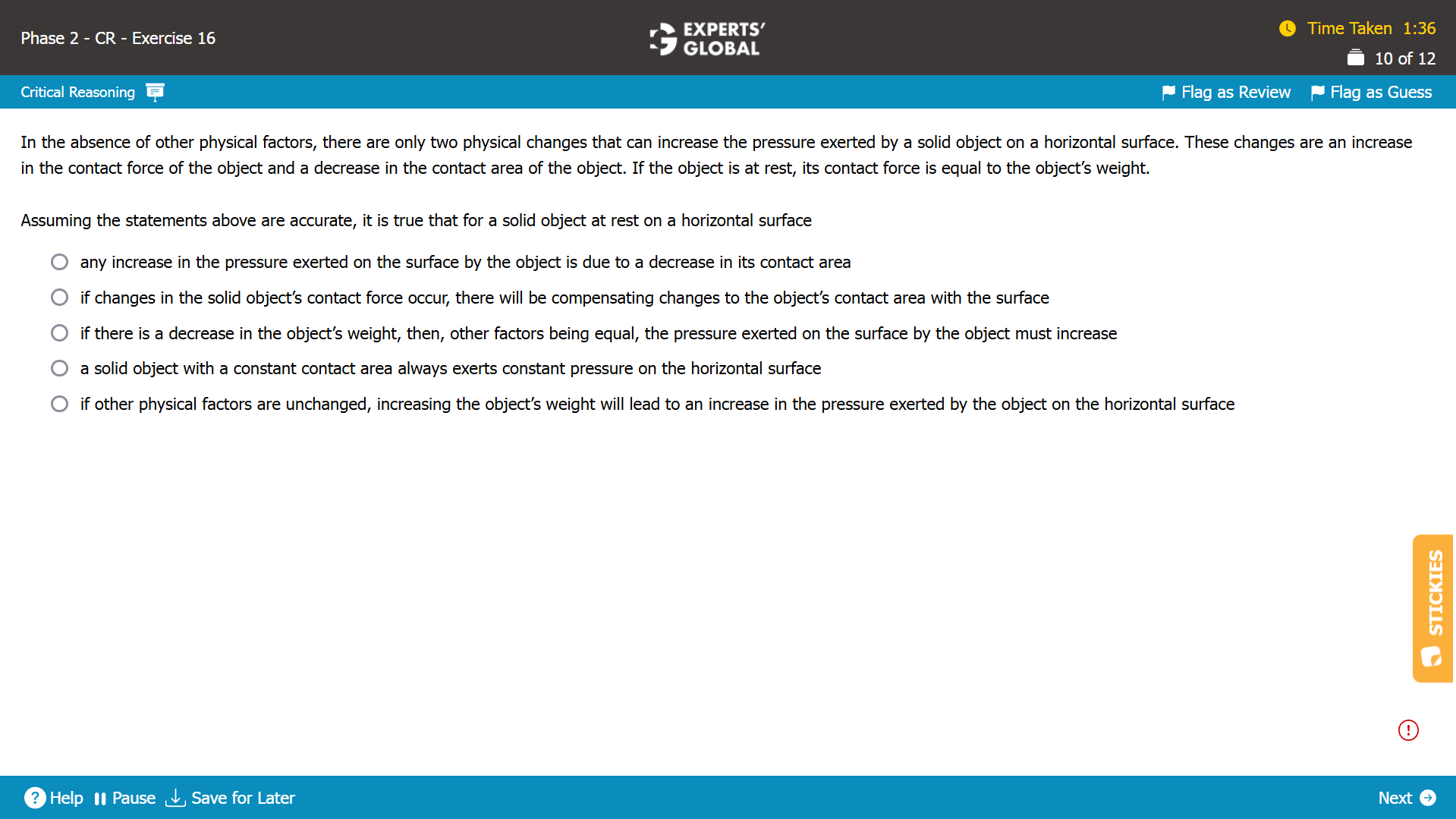
Show Explanation

Written Explanation
Mind-map: Two physical changes increase pressure → increase in contact force and decrease in contact area → for a stationary object, contact force is equal to the weight of the object
Missing-link: Not needed
Expectation from the correct answer choice: To be duly deducible from the information in the passage, without any assumption or extrapolation
A. The passage mentions that, in the absence of other physical factors, an increase in contact force and a decrease in contact area are the two changes that increase pressure; so, it is possible to increase pressure by increasing contact force and keeping contact area constant; hence, it is incorrect to state that “any increase” in pressure is due to a decrease in contact area, as the answer choice mentions. Because this answer choice is not deducible from the information in the passage without any assumption or extrapolation, this answer choice is incorrect.
B. The passage mentions that, in the absence of other physical factors, an increase in contact force and a decrease in contact area are the two changes that increase pressure; the passage makes no suggestion regarding a body’s tendency to compensate one physical change by initiating another physical change; so, it cannot be established that changes in contact force will lead to compensating changes in contact area, as the answer choice mentions. Because this answer choice is not deducible from the information in the passage without any assumption or extrapolation, this answer choice is incorrect.
C.The passage mentions that contact force is equal to the weight of the object; so, a decrease in weight indicates a decrease in contact force; additionally, the passage mentions that, in the absence of other physical factors, an increase in contact force increases pressure, suggesting that a decrease in contact force decreases pressure; overall, it can be established that a decrease in weight, or a decrease in contact force, decreases, rather than increase, pressure, contrary to what the answer choice mentions. Because this answer choice is not deducible from the information in the passage without any assumption or extrapolation, this answer choice is incorrect.
D. Trap.The passage mentions that, in the absence of other physical factors, an increase in contact force and a decrease in contact area are the two changes that increase pressure; so, when contact area remains constant, pressure is entirely dependent on contact force; hence, with a constant contact area, pressure will remain constant “only” if contact force remains constant too; so, is it incorrect to state that constant contact area “always” exerts constant pressure, as the answer choice mentions. Because this answer choice is not deducible from the information in the passage without any assumption or extrapolation, this answer choice is incorrect.
E. Correct. The passage mentions that contact force is equal to the weight of the object; so, an increase in weight indicates an increase in contact force; additionally, the passage mentions that, in the absence of other physical factors, an increase in contact force increases pressure; overall, it can be established that an increase in weight, or an increase in contact force thereby, increases pressure, as the answer choice mentions. Because this answer choice is deducible from the information in the passage without any assumption or extrapolation, this answer choice is correct.
E is the best choice.
High quality CR Inference questions are not available in large numbers. Among the limited, genuinely strong sources are the official practice materials released by GMAC and the Experts’ Global GMAT course. Within the Experts’ Global GMAT online preparation course, every CR Complete the Paragraph question appears on an exact GMAT like user interface that includes all the real exam tools and features. You work through more than 300 CR Complete the Paragraph questions in quizzes and also take 15 full-length GMAT mock tests that include several CR Complete the Paragraph questions in roughly the same spread and proportion in which they appear on the actual GMAT.
Remember…
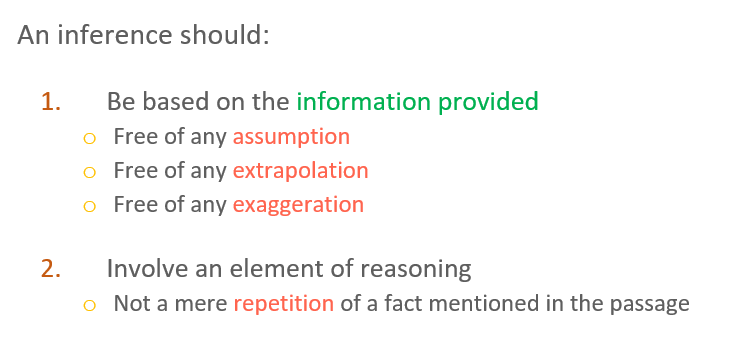
All the best!